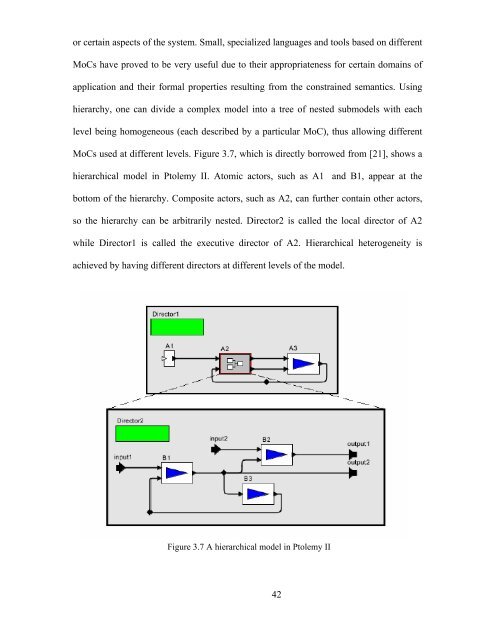Dynamic Dataflow Modeling in Ptolemy II - Ptolemy Project ...
Dynamic Dataflow Modeling in Ptolemy II - Ptolemy Project ...
Dynamic Dataflow Modeling in Ptolemy II - Ptolemy Project ...
You also want an ePaper? Increase the reach of your titles
YUMPU automatically turns print PDFs into web optimized ePapers that Google loves.
or certa<strong>in</strong> aspects of the system. Small, specialized languages and tools based on different<br />
MoCs have proved to be very useful due to their appropriateness for certa<strong>in</strong> doma<strong>in</strong>s of<br />
application and their formal properties result<strong>in</strong>g from the constra<strong>in</strong>ed semantics. Us<strong>in</strong>g<br />
hierarchy, one can divide a complex model <strong>in</strong>to a tree of nested submodels with each<br />
level be<strong>in</strong>g homogeneous (each described by a particular MoC), thus allow<strong>in</strong>g different<br />
MoCs used at different levels. Figure 3.7, which is directly borrowed from [21], shows a<br />
hierarchical model <strong>in</strong> <strong>Ptolemy</strong> <strong>II</strong>. Atomic actors, such as A1 and B1, appear at the<br />
bottom of the hierarchy. Composite actors, such as A2, can further conta<strong>in</strong> other actors,<br />
so the hierarchy can be arbitrarily nested. Director2 is called the local director of A2<br />
while Director1 is called the executive director of A2. Hierarchical heterogeneity is<br />
achieved by hav<strong>in</strong>g different directors at different levels of the model.<br />
Figure 3.7 A hierarchical model <strong>in</strong> <strong>Ptolemy</strong> <strong>II</strong><br />
42
















